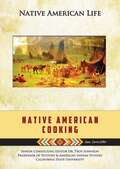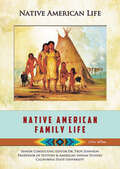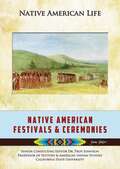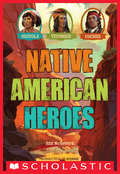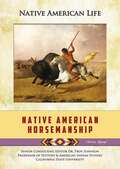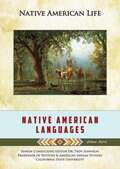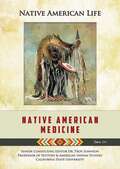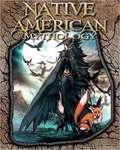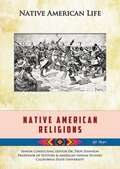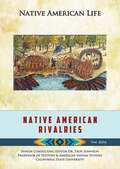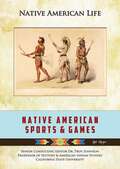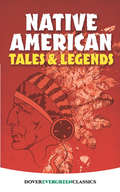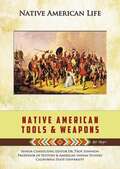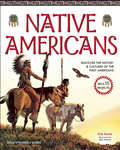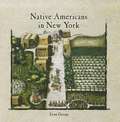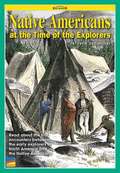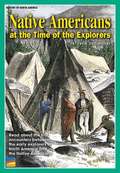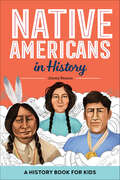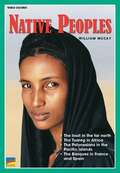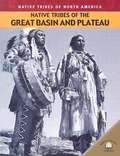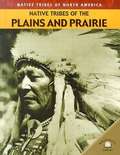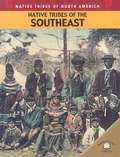- Table View
- List View
Native American Cooking (Native American Life)
by Anna Carew-MillerThe diet of Native American tribes reflected the areas in which they lived. For some tribes, like those of the Pacific Northwest, salmon was a staple part of the diet; for the people of the Great Plains, the buffalo was hunted for food. This book discusses the foods common to various tribes as well as the cultural significance certain foods had for specific tribes.
Native American Family Life (Native American Life)
by Colleen WilliamsTo an outsider, Native American family life may seem simple. In reality, the societies within Native American tribes are incredibly rich and complex. Nor is family life the same from tribe to tribe. Some tribes are organized into clans; others trace their lineage according to matrilineal lines. This book discusses some of the familial arrangements of various tribes, including the reasons for such arrangements as well as the roles individuals played in their respective societies.
Native American Festivals & Ceremonies (Native American Life)
by Jenna GlatzerFrom pre-Columbian times to the present day, Native Americans have enjoyed celebrating holidays and other special occasions. Tribes celebrated festivals and ceremonies throughout the year. These included everything from significant events in a person's life, the changing of the seasons, the arrival of special people or places, and elements of nature. This book discusses the important festivals and ceremonies celebrated by tribes in specific regions, outlining the form of the festival and how each was celebrated.
Native American Heroes: Osceola, Tecumseh And Cochise
by Ann McGovernNovember is Native American Heritage month!Osceola, Cochise, and Tecumseh are three Native American heroes who fought valiantly for their land and for their people. This book is divided into three parts--each part recounting the life of one of these great heroes. Their true stories are emotionally gripping and tragic, and Ann McGovern handles delicate topics, such as violence and racism, expertly for young readers. The narrative text is supplemented by black-and-white original source materials throughout (i.e. photographs, maps, portraits, a newspaper article).
Native American Horsemanship (Native American Life)
by Clarrissa AkyroydContrary to popular belief, Native Americans did not always have horses to assist them in their daily lives. For thousands of years they carried items themselves or even used dogs. The arrival of the horse in the Americas during the 16th century dramatically changed the lifestyles of many Native American tribes. This was particularly true of the people living on the Great Plains. This book discusses the introduction of the horse to the Native Americans by the Spanish and explains the impact this had on various Native American tribes.
Native American Languages (Native American Life #15)
by Bethanne PatrickPrior to becoming a "melting pot" of many languages, the continents of North and South America were already home to a variety of Native American tribes, each with its own language. What's more, subsets of tribes often had their own dialects, sometimes making communication between two people nearly impossible, even if they lived near each other. This book discusses the major Native American languages used by tribes in various regions and how some of their words have been incorporated into the English language today.
Native American Medicine (Native American Life #15)
by Tamra OrrNative Americans have an incredibly rich store of knowledge when it comes to using herbs and plants to heal illness, treat injuries, and cure disease. In fact, some of their traditions have found a place in the modern medicines we use today. This book discusses the nature-based approach Native Americans took towards healing. It also examines important figures, such as shamans and medicine men, and explains some of the remedies and rituals that were conducted.
Native American Mythology (World Of Mythology)
by Jim OllhoffWho is Kokyanwuuti? What is a shaman? Why are myths so important in our lives? Myths are a rich source of history. People use them to make sense of our world. Even before myths were written down, people told and retold the stories of the gods and goddesses of their homeland. Readers of American Indian Mythology will learn the history of myths, as well as their deeper meaning. From the Southeast tribes stories of how people got fire to the plains tribes stories of the Buffalo Woman, this book helps kids understand the myths that shape and direct people's lives.<P><P> Abdo & Daughters is an imprint of Abdo Publishing, a division of ABDO.
Native American Religions (Native American Life)
by Rob StaegerWhile Native American religious beliefs vary from tribe to tribe, the one thing they have in common is a belief in a higher power. This power has many names: Manitou, Wakanda, Sila, or even just the Great Spirit. This book discusses the various beliefs held by tribes in each region of the Americas. It also describes some of the important rituals practiced in each religion.
Native American Rivalries (Native American Life #15)
by Susan KeatingThe Native Americans fought with other tribes for a variety of reasons. Depending on the area in which they lived, a tribe could fight for territory, possessions, or simply as a matter of pride or to right a perceived wrong. This book discusses some of the best-known Native American rivalries, the reasons behind them, and the impact the arrival of Europeans during the 16th through the 19th centuries had on these rivalries.
Native American Sports & Games (Native American Life #15)
by Rob StaegerNative Americans loved to play games. From the United States to Mexico to Canada, tribes everywhere played games as part of their rituals, to cure diseases, to make crops grow, or sometimes, just for the pure fun of the sport. This book discusses the types of games played by various tribes in specific regions. It also explains how these games were played, and the significance-religious and social-of each contest.
Native American Tales and Legends (Dover Children's Evergreen Classics)
by Allan A. MacfarlanThis exciting collection contains more than thirty richly imaginative stories from a variety of Native American sources -- Cherokee to Zuñi, Pawnee to Midu -- covering a broad spectrum of subjects, as well as tales of little people, giants, and monsters, and of magic, enchantment, sorcery, and the spirit world.Readers will find stories telling how the earth, people, and bison were created and how fire was discovered, while others introduce the hero Glooscap and the Maiden of the Yellow Rocks. Still other traditional tales tell of the troubles Rabbit's boastfulness got him into, and about the clever ways Little Blue Fox managed to escape from Coyote.Among the stories in this collection are "The White Stone Canoe" (Chippewa), "Raven Pretends to Build a Canoe" (Tsimshian), "The Theft from the Sun" (Blackfoot), "The Loon's Necklace" (Iroquois), "The Rabbit Goes Duck Hunting" (Cherokee), "The Coyote" (Pueblo), and "The Origin of the Buffalo and of Corn" (Cheyenne). Young people will delight in these tales, as will any reader interested in Native American stories or folklore in general.
Native American Tools and Weapons (Native American Life #15)
by Rob StaegerThe tools and weapons used by Native American tribes were not just functional. Often, these tools and weapons were created during a special ceremony or ritual, so there was a spiritual significance to them as well. Shamans or medicine men would bless such items in the hope that they would serve their owners well. This book discusses the primary tools and weapons made by tribes in specific regions as well as how these tools and weapons were created and used.
Native Americans
by Kim Kavin Beth HetlandExplore how the first Americans, faced with varying climates in a vast land hundreds and thousands of years ago, developed everything we take for granted today: food supplies, shelter, clothing, religion, games, jewelry, transportation, communication, and more.Native Americans: Discover the History and Cultures of the First Americans uses hands-on activities to illuminate how the Native Americans survived and thrived by creating tools, culture, and a society based on their immediate environment. Entertaining illustrations and fascinating sidebars bring the topic to life, while Words to Know highlighted and defined within the text reinforce new vocabulary. Projects include building an archaic toolkit, creating Algonquin art, experimenting with irrigation systems, inventing hieroglyphics, making a "quinzy," and playing the Inuit game of nugluktaq. In addition to a glossary and an index, an extensive appendix of sites and museums all over the country offers ideas where families can learn more about the various Native American cultures.Kids ages 9-12 will gain an appreciation for the diversity of people and culture native to America, and learn to problem solve in a way that respects the environment.
Native Americans In New York (Primary Sources Of New York City And New York State Series)
by Lynn GeorgeNative Americans in New York by Lynn George
Native Americans at the Time of the Explorers
by Steven Otfinoski Margaret McnamaraLearn about the encounters between early explorers of the New World and the native people who lived in North America.
Native Americans at the Time of the Explorers: Text Pairs (Bridges/navigators Ser.)
by Steven OtfinoskiNIMAC-sourced textbook
Native Americans in History: A History Book for Kids (Biographies for Kids)
by Jimmy BeasonCelebrate the powerful stories of influential Native Americans—for kids ages 8 to 12From every background and tribal nation, native people are a vital part of history. This collection of Native American stories for kids explores 15 Native Americans and some of the incredible things they achieved. Kids will explore the ways each of these people used their talents and beliefs to stand up for what's right and stay true to themselves and their community.Becoming a leader—Learn how Sitting Bull led with spiritual guidance and a strong will, and how Tecumseh inspired warriors to protect their communities from white American hostility.Staying strong—Discover athletes like Maria Tallchief, who broke barriers in ballet, and Jim Thorpe, who showed the world that a native man could win Olympic gold.Fighting for change—Find out how Deb Haaland and Suzan Harjo use their activism to raise awareness about Native American issues today.Go beyond other books on Native American history for kids with a closer look at notable native people who helped change the world.
Native Americans: A Changing Landscape (Amplify Core Knowledge Language Arts Reader)
by Amplify Learning<P>Unit 8 includes Native American myths and stories from different tribes as well as nonfiction accounts. <P>"The Reader also includes two selections that may be used for enrichment. “The Navajo Code Talkers” explores the unique role Native Americans played during World War II, and “Ancestors’ Words” discusses the struggle to transmit and preserve the diverse languages spoken by Native Americans." (TG, Unit 8, p. 3)
Native Americans: Activity Book (Amplify Core Knowledge Language Arts, Grade 5 #Unit 8)
by Amplify EducationNIMAC-sourced textbook
Native Americans: Reader (Amplify Core Knowledge Language Arts, Grade 5 #Unit 8)
by Amplify EducationNIMAC-sourced textbook
Native Tribes of the Great Basin and Plateau (Native Tribes of North America Ser.)
by Michael Johnson Duncan ClarkeAn introduction to the history, culture, and people of the many Indian tribes that inhabited the region of the present states of Utah and Nevada and the mountainous area of the northwest United States and southern British Columbia in Canada.
Native Tribes of the Plains and Prairie (Native Tribes of North America)
by Michael JohnsonThis series provides a comprehensive reference library on the Native nations and peoples of North America, covering essential information on 400 different tribes. Organized according to traditional geographical and cultural groupings, this collection provides an informative view of the diversity of Native North America, from the Canadian Arctic to the Rio Grande. Each volume features historical photographs, regional maps, historic and updated census information, a guide to prominent museums specializing in Native culture, and a comprehensive index to the tribes featured in all six volumes.
Native Tribes of the Southeast (Native Tribes of North America Ser.)
by Michael Johnson Duncan ClarkeAn introduction to the history, culture, and people of the many Indian tribes that inhabited the region along the south Atlantic coast of the United States, around the Gulf of Mexico, and west to the Mississippi River.
